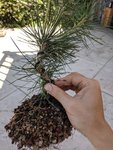AndyJ
Shohin
Hi folks,
My wife bought me a present yesterday - a Japanese White Pine - but it's growing from a fairly awful graft! It's only a young tree and will need a bit of growing time but I wonder if anyone has any tips for dealing with bad grafts?
Also, I saw a YouTube video where the guy said something about putting wire on the pine's trunk really tight so that it bites in to the bark, the idea being it will make the trunk swell? Does this work? Any tips for applying this technique?
Finally, the soil the tree is in very peaty; the tree has lots of new growth on the top so appears to be very healthy. Should I just leave it as it for the rest of this year? (The compost is draining pretty well.) Or slip pot it into something that's got some akadama / pumice / lava in it?
Many thanks,
Andy
My wife bought me a present yesterday - a Japanese White Pine - but it's growing from a fairly awful graft! It's only a young tree and will need a bit of growing time but I wonder if anyone has any tips for dealing with bad grafts?
Also, I saw a YouTube video where the guy said something about putting wire on the pine's trunk really tight so that it bites in to the bark, the idea being it will make the trunk swell? Does this work? Any tips for applying this technique?
Finally, the soil the tree is in very peaty; the tree has lots of new growth on the top so appears to be very healthy. Should I just leave it as it for the rest of this year? (The compost is draining pretty well.) Or slip pot it into something that's got some akadama / pumice / lava in it?
Many thanks,
Andy










